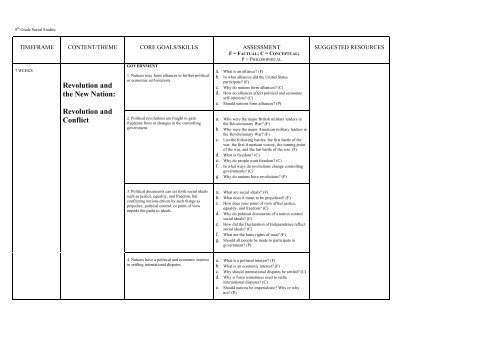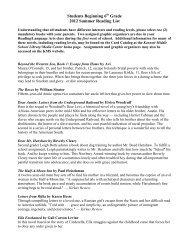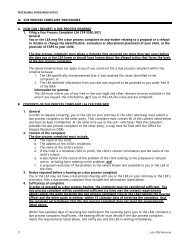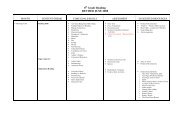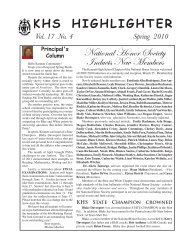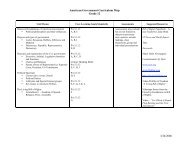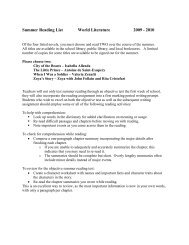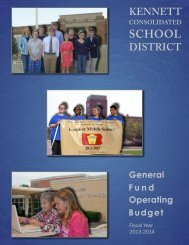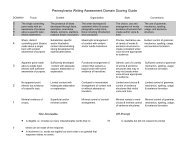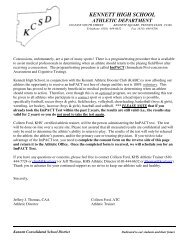Revolution and the New Nation: Revolution and Conflict
Revolution and the New Nation: Revolution and Conflict
Revolution and the New Nation: Revolution and Conflict
Create successful ePaper yourself
Turn your PDF publications into a flip-book with our unique Google optimized e-Paper software.
8 th Grade Social Studies<br />
TIMEFRAME CONTENT/THEME CORE GOALS/SKILLS ASSESSMENT<br />
F = FACTUAL; C = CONCEPTUAL;<br />
P = PHILOSOPHICAL<br />
7 WEEKS<br />
<strong>Revolution</strong> <strong>and</strong><br />
<strong>the</strong> <strong>New</strong> <strong>Nation</strong>:<br />
<strong>Revolution</strong> <strong>and</strong><br />
<strong>Conflict</strong><br />
GOVERNMENT<br />
1. <strong>Nation</strong>s may form alliances to fur<strong>the</strong>r political<br />
or economic self-interests.<br />
2. Political revolutions are fought to gain<br />
freedoms from or changes in <strong>the</strong> controlling<br />
government.<br />
a. What is an alliance (F)<br />
b. In what alliances did <strong>the</strong> United States<br />
participate (F)<br />
c. Why do nations form alliances (C)<br />
d. How do alliances affect political <strong>and</strong> economic<br />
self-interests (C)<br />
e. Should nations form alliances (P)<br />
a. Who were <strong>the</strong> major British military leaders in<br />
<strong>the</strong> <strong>Revolution</strong>ary War (F)<br />
b. Who were <strong>the</strong> major American military leaders in<br />
<strong>the</strong> <strong>Revolution</strong>ary War (F)<br />
c. List <strong>the</strong> following battles: <strong>the</strong> first battle of <strong>the</strong><br />
war, <strong>the</strong> first American victory, <strong>the</strong> turning point<br />
of <strong>the</strong> war, <strong>and</strong> <strong>the</strong> last battle of <strong>the</strong> war. (F)<br />
d. What is freedom (C)<br />
e. Why do people want freedom (C)<br />
f. In what ways do revolutions change controlling<br />
governments (C)<br />
g. Why do nations have revolutions (P)<br />
SUGGESTED RESOURCES<br />
3. Political documents can set forth social ideals<br />
such as justice, equality, <strong>and</strong> freedom, but<br />
conflicting notions driven by such things as<br />
prejudice, political control, or point of view<br />
impede <strong>the</strong> paths to ideals.<br />
a. What are social ideals (F)<br />
b. What does it mean to be prejudiced (F)<br />
c. How does your point of view affect justice,<br />
equality, <strong>and</strong> freedom (C)<br />
d. Why do political documents of a nation control<br />
social ideals (C)<br />
e. How did <strong>the</strong> Declaration of Independence reflect<br />
social ideals (C)<br />
f. What are <strong>the</strong> basic rights of man (F)<br />
g. Should all people be made to participate in<br />
government (P)<br />
4. <strong>Nation</strong>s have a political <strong>and</strong> economic interest<br />
in settling international disputes.<br />
a. What is a political interest (F)<br />
b. What is an economic interest (F)<br />
c. Why should international disputes be settled (C)<br />
d. Why is force sometimes used to settle<br />
international disputes (C)<br />
e. Should nations be imperialistic Why or why<br />
not (P)
5. Democratic governments seek public support<br />
<strong>and</strong> use compromise to settle national policy<br />
debates.<br />
a. What is democracy (F)<br />
b. What is compromise (F)<br />
c. Why do democratic societies create political<br />
parties (C)<br />
d. Why do governments need public support (C)<br />
e. Should political parties exist (P)<br />
6. Democracy is a type of government that<br />
creates order <strong>and</strong> promotes individual <strong>and</strong><br />
collective rights.<br />
a. How did <strong>the</strong> principle of “salutary neglect”<br />
change our relations with Great Britain (F)<br />
b. What is democracy (C)<br />
c. How does democracy strike a balance<br />
between individual <strong>and</strong> collective rights (C)<br />
d. Is order an obtainable goal (P)<br />
e. Whose definition of order should prevail (P)<br />
7. A society’s beliefs, values, <strong>and</strong><br />
experiences under foreign rule can lead to its<br />
quest for independence.<br />
a. What is an alliance (F)<br />
b. What was <strong>the</strong> Stamp Act (F)<br />
c. What were some of <strong>the</strong> compromises made at<br />
<strong>the</strong> Constitutional Convention (F)<br />
d. What is independence (C)<br />
e. How does tyranny breed desire for<br />
independence (C)<br />
f. Do a society’s beliefs <strong>and</strong> values change by<br />
evolution or revolution (P)<br />
8. Emerging nations overcome obstacles to<br />
establish democratic forms of government.<br />
HISTORY<br />
9. Political, ideological, religious <strong>and</strong> economic<br />
belief systems influenced <strong>the</strong> colonization of<br />
America <strong>and</strong> <strong>the</strong> American <strong>Revolution</strong>.<br />
a. What are several steps American colonists<br />
took to rid <strong>the</strong>mselves of British rule (F)<br />
b. Who were some influential leaders that<br />
encouraged resistance to <strong>the</strong> British (F)<br />
c. How did <strong>the</strong> British Parliament impede our<br />
quest for independence (F)<br />
d. Do all emerging nations have <strong>the</strong> same<br />
obstacles to overcome (C)<br />
e. What was most challenging obstacle <strong>the</strong><br />
colonists had to overcome (P)<br />
a. What rights did <strong>the</strong> colonists bring from <strong>the</strong>ir<br />
home countries (F)<br />
b. How did <strong>the</strong> belief systems impact <strong>the</strong><br />
establishment of colonial governments (C)<br />
c. How did <strong>the</strong> belief systems serve as a cause of <strong>the</strong><br />
American <strong>Revolution</strong> (C)<br />
d. How did <strong>the</strong> belief systems impact <strong>the</strong> formation<br />
of <strong>the</strong> early American government (C)
ECONOMICS<br />
10. Trade relationships guide foreign policy.<br />
CULTURE<br />
11. War can stimulate, depress, or decimate <strong>the</strong><br />
economy of a nation.<br />
a. What is salutary neglect (F)<br />
b. What is triangular trade (F)<br />
c. What is mercantilism (F)<br />
d. How did mercantilism <strong>and</strong> trade influence<br />
decisions with regard to relationships between<br />
nations (C)<br />
a. What is war (F)<br />
b. What effect did <strong>the</strong> American <strong>Revolution</strong> have on<br />
<strong>the</strong> colonial economy (F)<br />
c. How do wars affect an economy (C)<br />
d. Why do wars differ in <strong>the</strong>ir impact on an<br />
economy (C)<br />
e. Are wars fought by governments or by people<br />
(P)
TIMEFRAME CONTENT/THEME CORE GOALS/SKILLS ASSESSMENT<br />
F = FACTUAL; C = CONCEPTUAL;<br />
P = PHILOSOPHICAL<br />
SUGGESTED RESOURCES<br />
11 WEEKS<br />
The United States<br />
Constitution:<br />
Change <strong>and</strong><br />
Continuity<br />
1. The beliefs <strong>and</strong> values of people are reflected<br />
in government.<br />
a. What are <strong>the</strong> Articles of Confederation (F)<br />
b. What were <strong>the</strong> achievements <strong>and</strong> shortcomings of<br />
<strong>the</strong> Articles of Confederation (F)<br />
c. What are some of <strong>the</strong> values that <strong>the</strong> Preamble<br />
reflects (F)<br />
d. What are <strong>the</strong> six (6) purposes of government<br />
listed in <strong>the</strong> Preamble (F)<br />
e. How are certain beliefs <strong>and</strong> values of a society<br />
reflected in a democracy (C)<br />
f. Should all governments reflect <strong>the</strong> beliefs <strong>and</strong><br />
values of its people (P)<br />
2. The framework of <strong>the</strong> government develops in<br />
relation to changes in values, ideas, <strong>and</strong> events.<br />
a. What is <strong>the</strong> two-step process in Article V that<br />
allows <strong>the</strong> Constitution to change (F)<br />
b. Why do constitutions change (C)<br />
c. Should constitutions call for formal change (P)<br />
3. Regulating <strong>the</strong> balance between an individual’s<br />
rights <strong>and</strong> society’s needs is one function of a<br />
democratic government.<br />
a. What are some of <strong>the</strong> individual rights protected<br />
in <strong>the</strong> Bill of Rights (F)<br />
b. How do constitutions protect <strong>the</strong> rights of<br />
society (C)<br />
c. Whose rights are more important in a<br />
democracy—<strong>the</strong> individual or <strong>the</strong> group (P)<br />
4. In order to ensure <strong>the</strong> protection of individuals’<br />
rights <strong>and</strong> to maintain <strong>the</strong> common good, a<br />
government’s power may be limited by a<br />
constitution.<br />
a. How does <strong>the</strong> U. S. Constitution limit <strong>the</strong> federal<br />
government on behalf of <strong>the</strong> people (F)<br />
b. Why do governments write constitutions (C)<br />
c. What is <strong>the</strong> most important way a constitution<br />
limits government (P)<br />
d. Can a country protect its people without a<br />
constitution (P)<br />
Structure <strong>and</strong><br />
Principles of<br />
Government:<br />
Cooperation <strong>and</strong><br />
1. Power is separated in some<br />
governments in order to protect <strong>the</strong> rights<br />
of people.<br />
a. How is power divided in our federal government<br />
(F)<br />
b. How does a separation of power protect <strong>the</strong><br />
people (C)<br />
c. How does a separation of power cause conflict in<br />
government (C)<br />
d. Should all governments separate <strong>the</strong> power to<br />
protect <strong>the</strong> people (P)
Compromise<br />
2. A system of cooperation <strong>and</strong> compromise is<br />
important in a democratic government.<br />
a. What is <strong>the</strong> checks <strong>and</strong> balances system in<br />
American government (F)<br />
b. What is <strong>the</strong> 3/5 compromise (C)<br />
c. How does <strong>the</strong> checks <strong>and</strong> balances system<br />
safeguard <strong>the</strong> rights of <strong>the</strong> people in a<br />
democracy (C)<br />
d. Are cooperation <strong>and</strong> compromise within<br />
government possible in a democratic society (P)<br />
3. Democratic government implies limited<br />
government.<br />
a. What is popular sovereignty (F)<br />
b. How does a limited government protect <strong>the</strong><br />
people (C)<br />
c. Can a democratic government ever be too<br />
limited (P)<br />
d. How does an imbalance of power between <strong>the</strong><br />
branches of American government jeopardize <strong>the</strong><br />
concept of limited government (P)<br />
4. Democracy derives its power from <strong>the</strong> people.<br />
a. How are <strong>the</strong> people represented in <strong>the</strong> two houses<br />
of Congress (F)<br />
b. How do we see <strong>the</strong> power of <strong>the</strong> people in <strong>the</strong><br />
executive branch of our government (F)<br />
c. What is a census (F)<br />
d. What is <strong>the</strong> electoral college (F)<br />
e. Is <strong>the</strong> will of <strong>the</strong> people equally represented in <strong>the</strong><br />
judicial branch (P)<br />
Civic<br />
Participation in a<br />
Representative<br />
Democracy:<br />
Roles, Rights,<br />
<strong>and</strong><br />
Responsibilities<br />
1. Factions compete for control of<br />
government.<br />
2. Democratic citizenship is a privilege that<br />
confers not only rights but also responsibilities.<br />
a. What were <strong>the</strong> two earliest political<br />
parties in <strong>the</strong> U.S. (F)<br />
b. What is <strong>the</strong> difference between a political<br />
party <strong>and</strong> a special interest group (F)<br />
c. Why do political parties emerge in a<br />
democracy (F)<br />
d. Are political parties necessary in a<br />
democracy (C)<br />
a. What are some of our responsibilities as citizens<br />
What are some of our rights as citizens (F)<br />
b. How can citizens play a more active role in<br />
government (C)<br />
c. Should <strong>the</strong> rights of American citizens be limited<br />
to ensure domestic security (P)<br />
3. Democratic participation, membership, <strong>and</strong><br />
money afford <strong>the</strong> opportunity to influence<br />
government.<br />
a. What political institutions influence American<br />
government (F)<br />
b. Why is participation declining in <strong>the</strong> electoral<br />
process (C)<br />
c. How does <strong>the</strong> lack of citizen participation affect<br />
democracy (C)
4. Individuals <strong>and</strong> groups that participate in <strong>the</strong><br />
political process possess a political ideology that<br />
governs <strong>the</strong>ir values, beliefs, <strong>and</strong> positions on<br />
various issues.<br />
a. What democratic values are generally supported<br />
by a conservative, moderate, <strong>and</strong> liberal (C)<br />
b. How do people develop <strong>the</strong>ir individual<br />
ideologies (C)<br />
c. Why do citizens possess different political<br />
beliefs (P)<br />
State <strong>and</strong> Local<br />
Government:<br />
Order <strong>and</strong><br />
Independence<br />
1. State <strong>and</strong> local governments are<br />
interdependent of each o<strong>the</strong>r <strong>and</strong> <strong>the</strong> national<br />
government.<br />
a. What are <strong>the</strong> major powers of state<br />
governments (F)<br />
b. What are <strong>the</strong> three branches of Pennsylvania<br />
state government (F)<br />
c. How do local governments interact with <strong>the</strong><br />
Pennsylvania state government (C)<br />
d. How do levels of government compete for<br />
power (C)<br />
e. Should local <strong>and</strong> state governments have<br />
complete power over <strong>the</strong> education within a<br />
state (P)<br />
2. State <strong>and</strong> local governments reflect <strong>the</strong><br />
beliefs, values, <strong>and</strong> experiences of citizens.<br />
a. What major changes have been made to <strong>the</strong><br />
structure of Pennsylvania’s government since<br />
colonial times (F)<br />
b. What values <strong>and</strong> beliefs are reflected in <strong>the</strong><br />
Preamble to <strong>the</strong> Pennsylvania Constitution<br />
(F)<br />
c. How does <strong>the</strong> Pennsylvania government<br />
protect <strong>the</strong> rights of <strong>the</strong> people (F)<br />
d. Why might local governments in<br />
Pennsylvania provide different services <strong>and</strong><br />
enact different laws than local governments<br />
in o<strong>the</strong>r states (C)<br />
3. Economic conditions within a state affect<br />
<strong>the</strong> structure, powers, <strong>and</strong> duties of state <strong>and</strong><br />
local governments.<br />
a. How do state <strong>and</strong> local governments raise<br />
revenues (F)<br />
b. What are some criticisms of <strong>the</strong> property tax<br />
system (F)<br />
c. What are major categories of spending for<br />
state <strong>and</strong> local governments (F)<br />
d. How do economic conditions impact state<br />
<strong>and</strong> local governments (P)
4. State <strong>and</strong> local governments create laws<br />
<strong>and</strong> rules to establish order <strong>and</strong> provide<br />
services.<br />
a. What services do state <strong>and</strong> local<br />
governments provide (F)<br />
b. What responsibilities do state <strong>and</strong> local<br />
government officials have (F)<br />
c. What is <strong>the</strong> structure <strong>and</strong> function of <strong>the</strong><br />
court system in Pennsylvania (F)<br />
d. What government agencies provide services<br />
for citizens of state <strong>and</strong> local governments<br />
(F)<br />
e. How do state <strong>and</strong> local governments make<br />
laws (F)
TIMEFRAME CONTENT/THEME CORE GOALS/SKILLS ASSESSMENT<br />
F = FACTUAL; C = CONCEPTUAL;<br />
P = PHILOSOPHICAL<br />
9 WEEKS<br />
Expansion <strong>and</strong><br />
Reform<br />
(1801-1861)<br />
CULTURE<br />
1. Immigration, urbanization, <strong>and</strong><br />
industrialization generate increased<br />
social conflict as different cultures, with<br />
different values <strong>and</strong> beliefs, come into<br />
contact.<br />
a. What are three (3) problems associated with<br />
immigration in <strong>the</strong> cities (F)<br />
b. From what parts of Europe did early immigrants<br />
come (F)<br />
c. What are immigration, urbanization, <strong>and</strong><br />
industrialization (F)<br />
d. How did immigration, urbanization, <strong>and</strong><br />
industrialization affect <strong>the</strong> United States in <strong>the</strong><br />
early to mid-1800’s (F)<br />
e. Why do cultures have different values <strong>and</strong><br />
beliefs (C)<br />
f. Why is it important to know <strong>and</strong> underst<strong>and</strong> o<strong>the</strong>r<br />
cultures (C)<br />
g. Should cultures interact (P)<br />
SUGGESTED RESOURCES<br />
2. Leaders, groups <strong>and</strong> ordinary citizens can raise<br />
<strong>the</strong> social conscience in a community <strong>and</strong> create<br />
change by generating debate on issues of public<br />
concern <strong>and</strong> by motivating people to action.<br />
ECONOMICS<br />
3. Governments use tariffs to regulate trade <strong>and</strong><br />
to protect national business interests.<br />
a. What is social conscience (F)<br />
b. What is public concern (F)<br />
c. How might debate <strong>and</strong> compromise resolve an<br />
issue (C)<br />
d. How are people politically motivated (C)<br />
e. Does public debate create change (P)<br />
a. What is a tariff (F)<br />
b. How do governments regulate trade (F)<br />
c. Why is it necessary to regulate trade (C)<br />
d. Why do governments protect national business<br />
interests (C)<br />
a. Should governments set tariffs (P)<br />
4. Banks channel funds from savers to borrowers<br />
<strong>and</strong> investors to simulate <strong>the</strong> economy.<br />
a. What is a bank (F)<br />
b. What is an investor (F)<br />
c. How do borrowers <strong>and</strong> investors stimulate <strong>the</strong><br />
economy (C)<br />
d. Why didn’t <strong>the</strong> government control <strong>the</strong> economy<br />
in <strong>the</strong> early 1800’s (C)<br />
e. Should <strong>the</strong> government play a role in regulating<br />
<strong>the</strong> economy (P)
GOVERNMENT<br />
5. Labor movements seek to protect <strong>and</strong> extend<br />
<strong>the</strong> rights of workers.<br />
a. What is labor (F)<br />
b. Who are <strong>the</strong> early labor leaders (F)<br />
c. What led to <strong>the</strong> labor movement (F)<br />
d. How did labor movements affect <strong>the</strong> growth of<br />
cities (C)<br />
e. Why does <strong>the</strong> government try to protect workers’<br />
rights (C)<br />
f. Should <strong>the</strong> government protect workers’ rights<br />
(P)<br />
6. During this era <strong>the</strong> new government was<br />
established <strong>and</strong> new political parties were<br />
formed.<br />
a. What was <strong>the</strong> job of <strong>the</strong> cabinet (F)<br />
b. Who were <strong>the</strong> key people of early American<br />
government (F)<br />
c. How were <strong>the</strong> first political parties formed <strong>and</strong><br />
what were <strong>the</strong>y (F)<br />
d. How did <strong>the</strong> Alien <strong>and</strong> Sedition Acts <strong>and</strong> <strong>the</strong><br />
Virginia <strong>and</strong> Kentucky Resolutions challenge <strong>the</strong><br />
Constitution (C)<br />
e. What was <strong>the</strong> significance of Marbury vs.<br />
Madison (C)<br />
GOVERNMENT/ECONOMICS<br />
7. Sectional conflicts can potentially threaten<br />
political unity or undermine <strong>the</strong> economic power<br />
of a nation.<br />
CULTURE/GOVERNMENT<br />
8. Changing social <strong>and</strong> political beliefs lead to<br />
legislative <strong>and</strong> public policy reforms.<br />
a. Who are <strong>the</strong> early labor leaders (F)<br />
b. What is sectionalism (F)<br />
c. How does sectionalism threaten <strong>the</strong> unity of <strong>the</strong><br />
United States (F)<br />
d. How does sectionalism threaten <strong>the</strong> unity of a<br />
nation (C)<br />
e. Why does sectionalism threaten <strong>the</strong> economic<br />
power of a nation (C)<br />
f. Does sectionalism threaten a nation (P)<br />
a. Who were three (3) important women reformers<br />
during <strong>the</strong> expansion <strong>and</strong> reform era (F)<br />
b. Who were three (3) significant abolitionist<br />
leaders during <strong>the</strong> expansion <strong>and</strong> reform era (F)<br />
c. What are reforms (F)<br />
d. What factors lead to legislative reform in <strong>the</strong><br />
United States (F)<br />
e. Why do social <strong>and</strong> political beliefs lead to policy<br />
reforms (C)<br />
f. How do political leaders <strong>and</strong> citizens play a role<br />
in reform (C)<br />
g. Should governments initiate reform (P)
9. Social <strong>and</strong> political reformers use<br />
public demonstrations <strong>and</strong> persuasive<br />
media techniques to gain support for <strong>the</strong>ir<br />
cause.<br />
a. What is social conscience (F)<br />
b. What is a public demonstration (F)<br />
c. What techniques are used to gain media support<br />
for government (F)<br />
d. Why are social changes more prevalent in<br />
democracies (C)<br />
e. Why are public demonstrations effective (C)<br />
f. Should governments allow demonstrations (P)<br />
HISTORY<br />
10. The path of territorial expansion <strong>and</strong><br />
<strong>the</strong> settlement of <strong>the</strong> frontier included <strong>the</strong><br />
acquisition of new territories <strong>and</strong><br />
conflicts with <strong>the</strong> American Indians.<br />
a. What political events led to <strong>the</strong> Louisiana<br />
Purchase (F)<br />
b. What was <strong>the</strong> role of Lewis <strong>and</strong> Clark (F)<br />
c. How did <strong>the</strong> US desire for western l<strong>and</strong><br />
contribute to <strong>the</strong> cause of <strong>the</strong> War of 1812 (F)<br />
d. How did <strong>the</strong> War of 1812 influence <strong>the</strong> foreign<br />
policy <strong>and</strong> international st<strong>and</strong>ing of <strong>the</strong> US (C)<br />
e. How did <strong>the</strong> concept of Manifest Destiny<br />
contribute to <strong>the</strong> growth of <strong>the</strong> west (C)<br />
f. Why did people migrate to Oregon (F)<br />
g. How did Texas <strong>and</strong> <strong>the</strong> remainder of <strong>the</strong><br />
southwest become part of <strong>the</strong> US (F)<br />
h. How did <strong>the</strong> Gold Rush impact transportation <strong>and</strong><br />
communication (F)
TIMEFRAME CONTENT/THEME CORE GOALS/SKILLS ASSESSMENT<br />
F = FACTUAL; C = CONCEPTUAL;<br />
P = PHILOSOPHICAL<br />
9 WEEKS<br />
Civil War <strong>and</strong><br />
Reconstruction:<br />
Prejudice,<br />
<strong>Conflict</strong> <strong>and</strong><br />
Equality<br />
CULTURE<br />
1. Economic, social, <strong>and</strong> cultural differences<br />
can lead to a variety of perspectives on issues<br />
of public concern.<br />
a. What is culture (F)<br />
b. How are cultures different (F)<br />
c. How were <strong>the</strong> cultures of <strong>the</strong> North <strong>and</strong> South<br />
alike <strong>and</strong> different prior to <strong>the</strong> Civil War (F)<br />
d. What social <strong>and</strong> economic groups existed prior<br />
to <strong>the</strong> Civil War (F)<br />
e. What were some of <strong>the</strong> economic, social, <strong>and</strong><br />
cultural differences that led to different<br />
perspectives between <strong>the</strong> North <strong>and</strong> South (F)<br />
f. How do different values <strong>and</strong> perceptions<br />
between groups create conflict (C)<br />
g. Why does prejudice often exist between<br />
different groups of people (C)<br />
h. What factors lead to prejudice <strong>and</strong><br />
discrimination (C)<br />
i. Is inequality unique to <strong>the</strong> Civil War era (C)<br />
j. Do all nations believe that people should be<br />
treated equally (P)<br />
SUGGESTED RESOURCES<br />
2. Different perspectives can generate social<br />
<strong>and</strong> political conflict.<br />
a. What were some of <strong>the</strong> belief systems about<br />
<strong>the</strong> institution of slavery (F)<br />
b. Why are value conflicts particularly heated <strong>and</strong><br />
difficult to resolve (C)<br />
c. Why would disputes over slavery be<br />
considered a conflict of values (P)<br />
d. Can you think of any o<strong>the</strong>r “value conflicts” in<br />
today’s society (P)<br />
3. Availability of human <strong>and</strong> material resources<br />
provides a tactical advantage in times of war.<br />
a. What resources were available to <strong>the</strong> North <strong>and</strong><br />
<strong>the</strong> South during <strong>the</strong> Civil War (F)<br />
b. What advantage did <strong>the</strong> North have over <strong>the</strong><br />
South (F)<br />
c. What were some of <strong>the</strong> common battlefield<br />
tactics during <strong>the</strong> Civil War (F)<br />
d. Are <strong>the</strong> tactics used on <strong>the</strong> battlefield of <strong>the</strong><br />
Civil War still integrated into present day<br />
conflicts (C)<br />
e. What were some of <strong>the</strong> qualities of leadership<br />
that benefited ei<strong>the</strong>r side of <strong>the</strong> war (C)
4. Civil war generates problems <strong>and</strong> solutions<br />
to a political conflict.<br />
5. Civil war is an imbalance between<br />
intolerance <strong>and</strong> acceptance among varying<br />
social groups.<br />
6. In order to create enduring social change,<br />
civil wars depend on changing perspectives.<br />
GOVERNMENT/CULTURE<br />
7. Reconstruction following war is driven by<br />
political ideology, as well as basic economic<br />
<strong>and</strong> social needs.<br />
a. What is civil war (F)<br />
b. What problems were created during <strong>the</strong> U.S.<br />
Civil War (F)<br />
c. What social groups were involved in <strong>the</strong> Civil<br />
War (F)<br />
d. How does war create a solution to a political<br />
problem (C)<br />
e. Do civil wars solve or create internal<br />
problems (P)<br />
a. What is <strong>the</strong> difference between tolerance <strong>and</strong><br />
intolerance (F)<br />
b. What compromises were tried prior to <strong>the</strong> Civil<br />
War (F)<br />
c. How can varying perspectives among different<br />
social groups lead to conflict (C)<br />
d. Was <strong>the</strong> Civil War inevitable (P)<br />
a. What resources were available to <strong>the</strong> North <strong>and</strong><br />
<strong>the</strong> South during <strong>the</strong> Civil War (F)<br />
b. What are some of <strong>the</strong> personal perspectives of<br />
people during this era (F)<br />
c. What personal perspectives did not change as a<br />
result of <strong>the</strong> war (F)<br />
d. Why can deeply held personal perspectives<br />
lead to civil war (C)<br />
e. Does war create social change (P)<br />
a. Why do societies create different political<br />
systems (F)<br />
b. What is sectionalism (F)<br />
c. What economic <strong>and</strong> social problems existed<br />
after <strong>the</strong> Civil War (F)<br />
d. What different political solutions were<br />
suggested by <strong>the</strong> government (C)<br />
8. Political compromise builds on shared<br />
values <strong>and</strong> perspectives between groups <strong>and</strong><br />
nations in conflict.<br />
a. What is compromise, <strong>and</strong> why do people<br />
compromise (F)<br />
b. Does compromise promote lasting solutions<br />
(C)<br />
c. Are <strong>the</strong>re values <strong>and</strong> beliefs that cannot be<br />
compromised (P)


